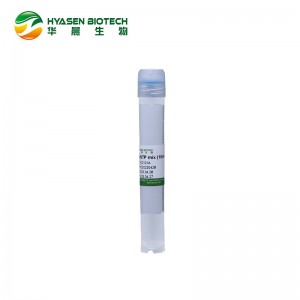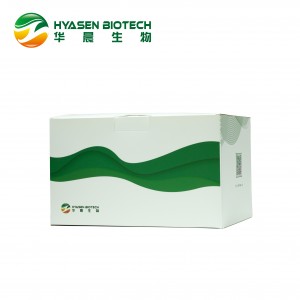
Mouse Genotyping Kit
Cat No: HCR2021A
This product is a kit designed for the rapid identification of mouse genotypes, including DNA crude extraction and PCR amplification system. The product can be used for PCR amplification directly from mouse tail, ear, toe and other tissues after simple cleavage by Lysis Buffer and Proteinase k. No overnight digestion, phenol-chloroform extraction or column purification, which is simple and shortens the time consuming of experiments. The product is suitable for amplification of target fragments up to 2kb and multiplex PCR reactions with up to 3 pairs of primers. The 2×Mouse Tissue Direct PCR Mix contains genetically engineered DNA polymerase, Mg2+, dNTPs and an optimized buffer system to provide high amplification efficiency and inhibitor tolerance, so that PCR reactions can be carried out by adding template and primers and rehydrating the product to 1×. The PCR product amplified with this product has a prominent “A” base at the 3′ end and can be used directly for TA cloning after purification.
Components
|
Component |
Size |
|
2×Mouse Tissue Direct PCR Mix |
5×1.0mL |
|
Lysis Buffer |
2×20mL |
|
Proteinase K |
800μL |
Storage Conditions
Products should be stored at -25~-15℃ for 2 years. After thawing, Lysis Buffer can be stored at 2~8℃ for short-term multiple use, and mix well when using.
Application
This product is suitable for mouse knockout analysis, transgenic detection, genotyping and so on.
Features
1. Simple operation: no need to extract genomic DNA;
2. Wide application: suitable for direct amplification of various mouse tissues.
Instructions
1. Release of genomic DNA
1) Preparation of lysate
Tissue lysate is prepared according to the number of mouse samples to be lysed (tissue lysate should be prepared on-site according to the dosage and mixed thoroughly for use), and the proportion of reagents required for a single sample is as follows:
|
Components |
Volume (μL) |
|
Proteinase K |
4 |
|
Lysis Buffer |
200 |
2) Sample Preparation and Lysis
Recommended Tissue Use
|
Type of Tissue |
Recommended Volume |
|
Mouse tail |
1-3mm |
|
Mouse ear |
2-5mm |
|
Mouse toe |
1-2 pieces |
Take an appropriate amount of mouse tissue samples in clean centrifuge tubes, add 200μL of fresh tissue lysate to each centrifuge tube, vortex and shake, then incubate at 55℃ for 30mins, and then heat at 98℃ for 3mins.
3) Centrifugation
Shake the lysate well and centrifuge at 12,000 rpm for 5mins. The supernatant can be used as template for PCR amplification. If the template is needed for storage, transfer the supernatant to another sterile centrifuge tube and store at -20℃ for 2 weeks.
2. PCR Amplification
Remove the 2×Mouse Tissue Direct PCR Mix from -20℃ and thaw on ice, mix upside down and prepare the PCR reaction system according to the following table (operate on ice):
|
Components |
25μL System |
50μL System |
Final Concentration |
|
2×Mouse Tissue Direct PCR Mix |
12.5μL |
25μL |
1× |
|
Primer 1 (10μM) |
1.0μL |
2.0μL |
0.4μM |
|
Primer 2 (10μM) |
1.0μL |
2.0μL |
0.4μM |
|
Cleavage Product a |
As require |
As require |
|
|
ddH2O |
Up to 25μL |
Up to 50μL |
|
Note:
a) The amount added should not exceed 1/10 of the system, and if too much is added, PCR amplification may be inhibited.
Recommended PCR Conditions
|
Cycle step |
Temp. |
Time |
Cycles |
|
Initial denaturation |
94℃ |
5mins |
1 |
|
Denaturation |
94℃ |
30sec |
35-40 |
|
Annealing a |
Tm+3~5℃ |
30sec |
|
|
Extension |
72℃ |
30 sec/kb |
|
|
Final extension |
72℃ |
5mins |
1 |
|
- |
4℃ |
Hold |
- |
Note:
a) Annealing temperature: With reference to the Tm value of the primer, it is recommended to set the annealing temperature to the smaller Tm value of the primer +3~5℃.
Common Problems and Solutions
1. No targeted strips
1) Excessive lysis product. Choose the most appropriate amount of template, usually not more than 1/10 of the system;
2) Too large sample size. Dilute the lysate 10 times and then amplify, or reduce the sample size and re-lysis;
3) Tissue samples are not fresh. It is recommended to use fresh tissue samples;
4) Poor primer quality. Use genomic DNA for amplification to verify the primer quality and optimize the primer design.
2. Non-specific amplification
1) The annealing temperature is too low and the cycle number is too high. Increase the annealing temperature and reduce the number of cycles;
2) Template concentration is too high. Reduce the amount of template or dilute the template 10 times after amplification;
3) Poor primer specificity. Optimize the primer design.
Notes
1. In order to avoid cross contamination between samples, multiple sampling tools should be prepared, and the surface of the tools can be cleaned with 2% sodium hypochlorite solution or nucleic acid cleaner after each sampling if repeated use is required.
2. It is recommended to use fresh mouse tissues, and the sampling volume should not be too large to avoid affecting the amplification results.
3. Lysis Buffer should avoid frequent freeze-thaw, and can be stored at 2~8℃ for short-term multiple use. If stored at low temperature, precipitation may occur, and must be fully dissolved before use.
4. PCR Mix should avoid frequent freeze-thaw, and can be stored at 4℃ for short-term repeated use.
5. This product is only for scientific experimental research and should not be used in clinical diagnosis or treatment.








-300x300.jpg)





